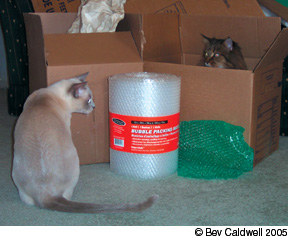Although you may be caught up in the excitement of moving into a new home, your cat may be less than enthusiastic. Most cats are creatures of habit, and the change will likely upset his habits. Cats like routine and consistency, says Pamela Perry, DVM, animal behavior resident at Cornell Universitys College of Veterinary Medicine. Moving changes everything, and your cat feels like hes in a foreign environment.

288
To make matters worse for your cat, you may seem different and preoccupied with all that a move requires. Hell watch you packing, hauling furniture or directing the movers as they remove what he perceives as his belongings. At the new home, the process reverses in an unfamiliar territory. The house smells different, and nothing is where it belongs. If your cat cant cope, he may find ways to alleviate the tension that result in behavior problems. The whole situation is stressful, says Dr. Perry. Overgrooming, hiding, a lack of appetite, howling at night, excessive vocalization, elimination problems, compulsive disorders, as well as scratching territory are all ways a cat may deal with the situation.
An Ounce of Prevention
Make certain the new home is cleaned thoroughly before moving. If you know there were pets living there before, get it thoroughly cleaned, says Dr. Perry. Use an enzyme product to break down odors. As a precaution, treat the carpets for fleas. If you are moving into an apartment, check with management and ask what type of cleaning and maintenance took place between tenants.
If traveling is not overly stressful for your cat and if you are moving locally, you can take your cat to visit the new home prior to the move. Bring one of the cats favorite beds so he has his scent, says Dr. Perry. Some cats do appreciate novelty, so try to make the visit as fun as possible. Lay a trail of catnip throughout the new home. If youve taken a few boxes to unpack, let your cat play in the empty boxes. Encourage your cat to play, says Dr. Perry. However, if your cat is terrified by traveling in a car, taking him on short trips to the new home may not help.
Spraying the new environment with a pheromone product – or using a plug-in pheromone diffuser – may help ease your cat into his new surroundings. For most cats, pheromone products may help calm them and familiarize them to new surroundings, says Dr. Perry.
A Pound of Cure
On moving day, place your cat in a carrier for his safety. There is a lot of movement in and out of the house, and the last thing you want to do is lose your cat, says Dr. Perry. Give the cat his own quiet space until things have settled down.
Once at your new home, confine your cat for a few days in one room with all of his belongings while you unpack and get the house together. Confinement is a good idea, especially if its a major move and the cat may be overwhelmed, says Dr. Perry. This will give him a room to claim as his own, even when he later has access to the entire house. Place his litter box, food bowls and other belongings in the room. Let the cat out for brief periods so he can explore.
Not the End of the Road
Many people consider moving to be a good time to relinquish the cat to a shelter, opting to get a new cat when they arrive at their new home. Cats are not disposable items, says Dr. Perry. If the cat has a problem that is preventing you from keeping the cat, deal with that problem. Otherwise, the same problems may develop with a new cat in a new home.
If you are moving to a location that has a lengthy quarantine requirement, and you feel that placing your cat in a new home is the best option, make certain that the cat gets the right home. Sometimes family members will step in and help, says Dr. Perry. If no one is available, interview prospective pet parents before sending your cat to a new home.



